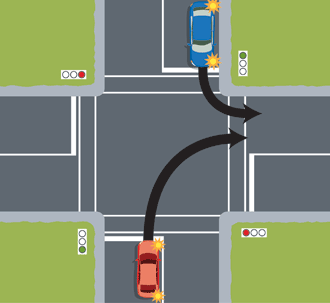
Where two vehicles are facing each other at an intersection with no signs or signals or the same signs or signals (in this case green traffic signals) a vehicle turning right must give way to a vehicle turning left.
Both cars have a green light, but the turning car (the red car), must give way to the car travelling straight through (the blue car).
The blue car must stop at the Give Way sign and give way to the red car.
You are leaving the road's course and turning into another road, therefore you must indicate left, even though your direction is fundamentally straight on.
The blue car is at a stop sign and therefore must give way to the red car which is travelling straight through the intersection.
This one is tricky, but the rules state that if you are passing more than 'halfway' around the roundabout, technically you are turning right, therefore you need to indicate right when approaching the roundabout and left as you pass the exit just before the one you want to take. In this case the road can't really be considered to be going straight through and it's not obviously a continuation of the road you've arrived on.
The red car is coming from the blue car's right but it's at a give way sign, therefore must give way to the blue car.
Advertisement
Where two vehicles are facing each other at an intersection with the same signs or signals or no signs or signals (as in this case) a vehicle turning right must give way to a vehicle turning left.
You are following the natural course of the road and therefore don't need to indicate.
The blue car must stop at the stop sign and give way to the red car.
The red car is turning from a give way sign at a t-intersection and therefore must give way to the blue car which is travelling straight through.